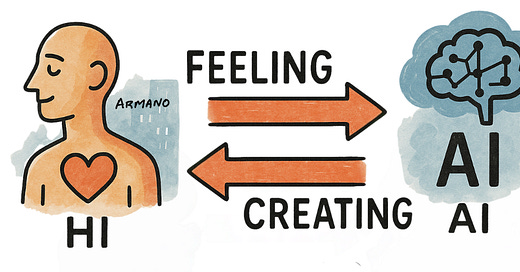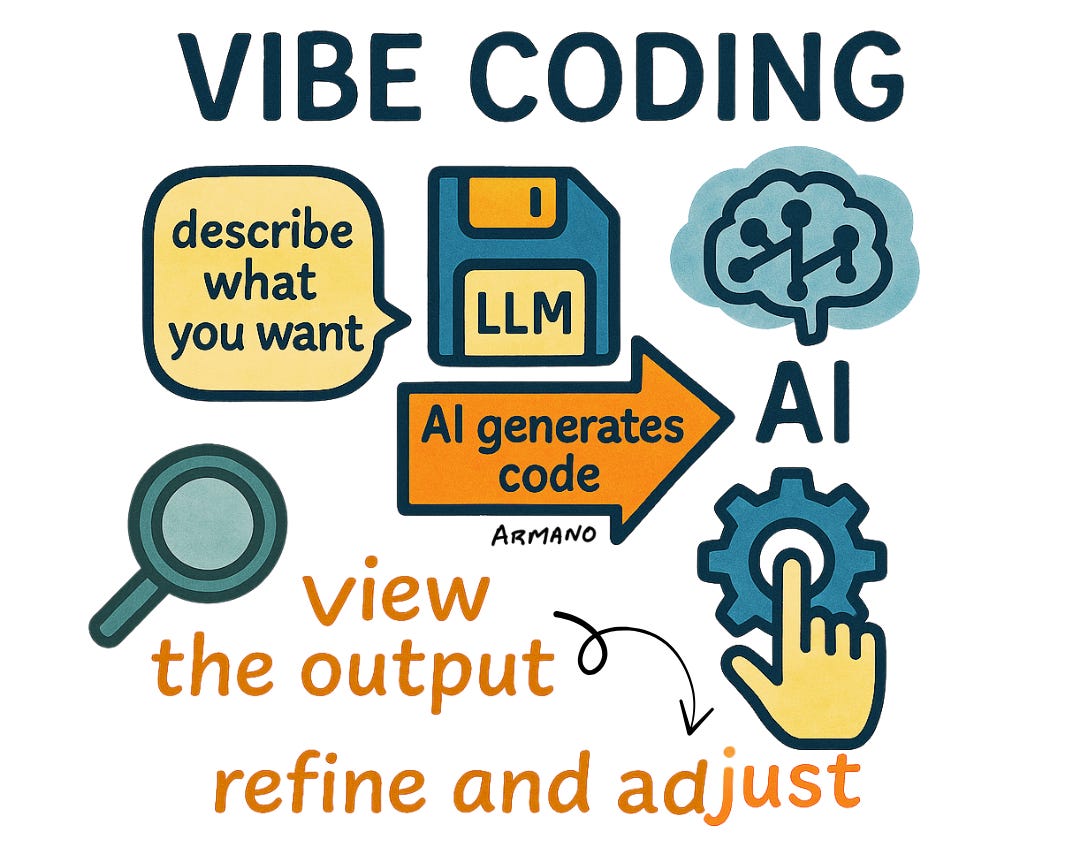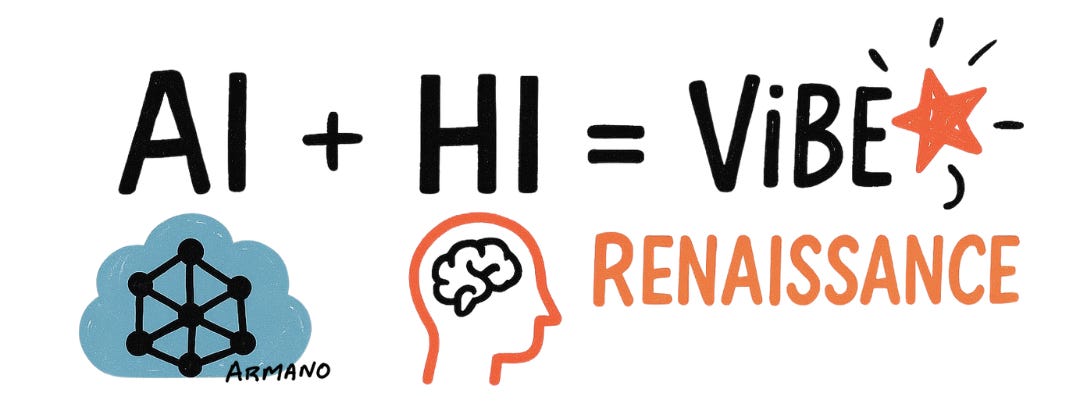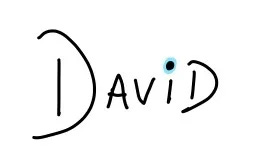AI’s Vibe Renaissance Is Intuitively Human
Human Intuition Is Resetting The Rules For Making With The Machine
“More human than human.”
— Blade Runner
We’ve spent decades teaching machines how to think. Now, in a strange twist, we’re learning how to feel again, alongside them as machine and human make stuff together.
This isn’t about AI replacing human creativity. It’s about how intuition, emotion, and instinct are showing up—amplified, in the age of the machine. We’re entering what I call a Vibe Renaissance: a moment where algorithms can generate, remix, and refine, but the spark—the vibe- is still ours to ignite. And ironically, it’s that very spark that’s resetting the rules.
Here’s what we’ll be exploring in this weekend’s vibe-filled newsletter:
AI is entering a “Vibe Renaissance”—where emotional tone and resonance are becoming as important as logic and output.
Human intuition (HI) is resetting the creative rules, guiding how we co-create with machines.
“Vibe coding” is a new way of programming, where prompts replace syntax and feeling shapes the output.
Creators across fields—writing, design, video, marketing—are becoming vibe directors, not just content producers.
Feeling is the new building—and emotional alignment is now a key design input, not just a byproduct.
AI + HI isn’t automation—it’s amplification of human creativity, taste, and cultural sensitivity.
AI is starting to mirror us not just in logic or language, but in rhythm, tone, and emotional resonance. Tools are becoming increasingly adept at “getting the vibe right,” and yet, the human hand is more essential than ever. Why? Because vibe isn’t just a mood. It’s context. It’s culture. It’s a lived-in sense of what feels right—and what doesn’t.
A Brief Introduction To Vibe Coding
Vibe coding is an emerging approach to software creation where natural language prompts take center stage—users describe what they want in plain English (or whatever human language). A powerful, large language model (LLM) generates working code. Instead of writing lines of logic, you guide, test, and refine the AI’s output. In other words, coding becomes more “vibe” than syntax-driven. The concept was introduced by Andrej Karpathy (OpenAI co-founder) in February 2025 and has been gaining attention ever since.
If “Agentic” is the buzzword of 2024-25, I think we’ll look back at “Vibe Coding” as the buzzphrase of 2025-26.
How does it work?
Prompt in plain language: e.g., “Build a signup form with a clean, playful UI.”
AI generates code: LLM produces components, layout, and styling.
Review by feel: You test it in-browser—does the vibe land?
Iterate conversationally: “Make the button warmer.” “Add a hover animation with bounce.” You let the AI remix until the feeling fits.
You’re not debugging logic line by line, but instead curating emotional tone, flow, and experience.
Why does it matter?
Democratizes creation. Non-technical creators can prototype games, apps, and websites using just dialogue. In The Times UK, a non-coder built a retro-style game in minutes using Claude and Lovable—“Meatball Mania”—a sign of how broadly accessible coding is becoming.
Accelerates ideation. Venture investors, such as Y Combinator, report that early-stage startups are now using vibe coding to iterate, reducing development time from months to weeks rapidly.
Expanding roles. Even product designers, who are not engineers, are building apps through vibe coding. For example, Cynthia Chen at Block built “Dog‑e‑dex,” an AI dog breed identifier, over two months using prompts, refinement, and gentle iteration.
Who’s doing it?
AI developers & power users. Tech leaders like Karpathy, IBM strategists, and prompt‑savvy engineers are exploring the boundaries.
Non‑technical creators. Journalists, designers, even hobbyists are shipping prototypes—and learning by feeling out prompts.
Startups. Companies like Lovable (now nearing a $2 billion valuation) adopt vibe coding to empower anyone, whether a developer or not, to build apps via conversational prompts.
“You don’t write code anymore—you just see things, say things, run things… and copy‑paste things, and it mostly works.”
— Andrej Karpathy, 2025
Vibe coding isn’t about writing precise, maintainable code—it’s about sketching ideas with prompts, feeling through iterations, and embracing a more fluid, emotionally attuned interaction with code. It opens doors for ideation, lowers technical barriers, and offers a new frontier where artificial intelligence meets human intuition.
The Vibe Renaissance: Where AI Meets “HI”
We’re entering an era where Artificial Intelligence (AI) is no longer just a tool—it’s a collaborator. But the real magic happens when AI is paired with something more profound: Human Intuition (HI). Intuition. Taste. Emotional literacy. Cultural fluency. The things that don’t show up on a spreadsheet but shape everything we feel, experience, and remember.
This fusion is what’s giving rise to a Vibe Renaissance, a moment where feeling is fast becoming the new creative infrastructure. It’s no longer just about building something that functions; it's about building something that lasts. It’s about crafting something that feels right, and AI, guided by human sensibility, is making that not only possible but scalable.
Let’s look at how this plays out across multiple domains:
Marketing
Savvy marketers aren’t just using AI to write headlines or generate copy—they’re prompting it to hit a specific emotional tone: bold but not arrogant, witty but not snarky. Campaigns are being vibe-tested across customer-inspired personas (more on synthetic research later) with generative tools offering dozens of variations in voice and format. What wins isn’t the most optimized message—it’s the one that feels most aligned with the moment.
Example: A DTC brand runs dozens of AI-generated ad variants and then filters them based on emotional resonance, using brand archetypes. The team selects the one that nails “modern nostalgia.” That’s HI shaping AI output.
Video Creation
Platforms like Runway and Pika enable creators to generate entire videos with a single prompt. But what makes a clip compelling isn’t just motion, polish or hyperealism—it’s pacing, mood, vibe. Creators now art-direct AI with cinematic references, such as “A24-style lighting,” “90s MTV energy,” and “dreamlike but grounded.” That’s not prompt engineering—it’s vibe directing.
Example: An indie musician creates a video using AI, refining it frame by frame to evoke heartbreak without melodrama. It connects because it feels human, not because it’s technically perfect.
Writing
AI can generate words, but it takes a human to interpret the meaning behind them. Writers now co-author with AI—drafting, remixing, and adjusting tone until it lands just right. Vibe isn’t just what you say—it’s how it flows. The cadence. The emotional undertone. The pause where a punchline lands.
Example: A thought leader uses ChatGPT to riff on five opening takes for a newsletter. One nails the vibe: grounded, curious, a touch rebellious. That’s HI at work, tuning the machine. I’ve been vibing with AI as a writer for a while now. These are my ideas, my words, my editing and discernment—all augmented with AI, painstakingly trained on my voice/personality and tone.
Graphic Design & Visual Storytelling
Midjourney, DALL·E, and other tools can render just about anything, but they don’t know what feels on brand, what aligns with the culture, or what hits emotionally. Designers now prompt visuals by feel: “hand-drawn with a hint of rebellion,” “corporate minimalism, but with soul.” They’re vibe coding visual identity.
Example: A campaign concept is visualized in ten AI directions—but only one nails the elusive combo of playfulness and trust. The designer picks it. That’s HI filtering AI outputs by emotional fluency.
Product Prototyping
Prototyping isn’t just about validating functionality anymore—it’s about sensing emotional fit early. Creators are using AI to quickly sketch out not just what a product does, but how it feels. From interface mockups to product copy to onboarding flows, vibe is being tested in real-time. You don’t wait for launch to see if it resonates—you co-create it with the vibe in mind from day one. And you do it faster, more iteratively.
Example:
A healthcare equipment manufacturer is launching a new patient-facing digital interface for an at-home diagnostic tool. Rather than defaulting to sterile, overly clinical UX, the team uses AI to prototype versions that communicate care, reassurance, and ease. They prompt for vibes like “calm confidence,” “approachable professionalism,” and “gentle clarity.” Each prototype is reviewed not just by clinicians, but by actual patients. The one that resonates most feels less like a device, more like a trusted companion. That’s vibe prototyping: emotion-led iteration in a high-stakes industry.
This isn’t just a creative shift—it’s a new way of thinking about building itself. The old mindset was: design, test, deploy. The new mindset is: sense, feel, co-create. We’re no longer just engineers or designers—we’re vibe architects, shaping how things land, not just how they look or behave.
In this renaissance, AI brings speed, scale, and possibility. Human intuition brings taste, timing, and emotional truth. Together, they’re reshaping how we create—and what we expect from creation itself.
Here’s to the Vibe Renaissance, and vibing… by design.
Visually yours,















Nice. See also…https://www.linkedin.com/posts/eaonpritchard_bashing-it-out-adnews-activity-7348824603290451973-5pkC?utm_source=share&utm_medium=member_ios&rcm=ACoAAACDEIsBZ8iIJFAyw24K8-JbR5kSGdv7NRs
This resonates deeply with how I have come to embrace AI’s. I treat it as a lab experiment to stretch boundaries and articulate what I couldn’t do prior to AI tools.